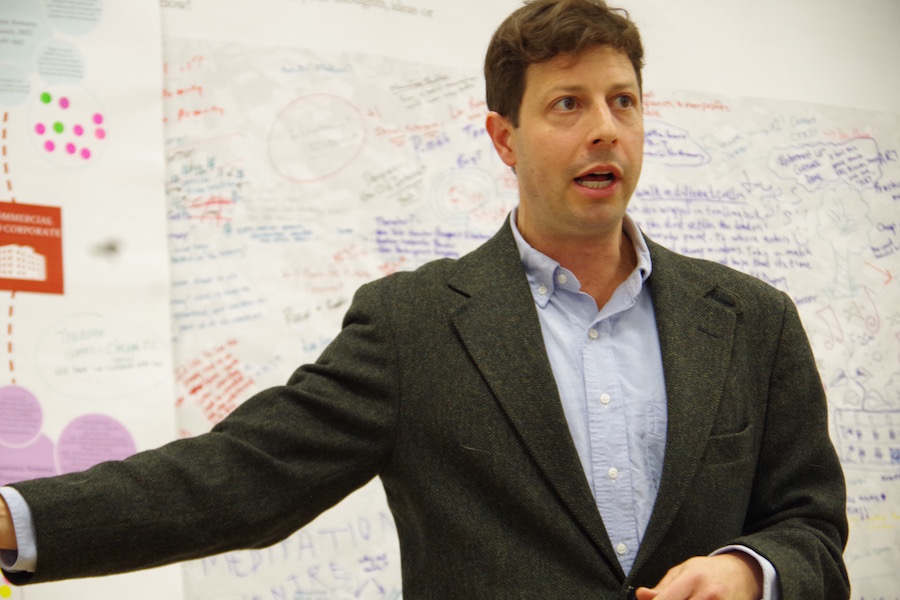
Rubin: Should the city pay for a rehab? Lucy Gellman Photos.
A cafe with a dance hall, and pod-sized recording spaces off to the side. A yoga studio, indoor garden and arboretum. Housing for homeless New Haveners who are getting back on their feet.
Last week, those were just a few ideas floated for the Goffe Street Armory at the Whalley-Edgewood-Beaver Hills (WEB) Community Management Team meeting, held in its usual location at the 332 Whalley Ave. police substation. They mark the latest and most community-focused chapter in “Excavating The Armory,” a collaboration between Yale Professor Elihu Rubin, Yale School of Architecture students, New Haven Academy students and Artspace New Haven.
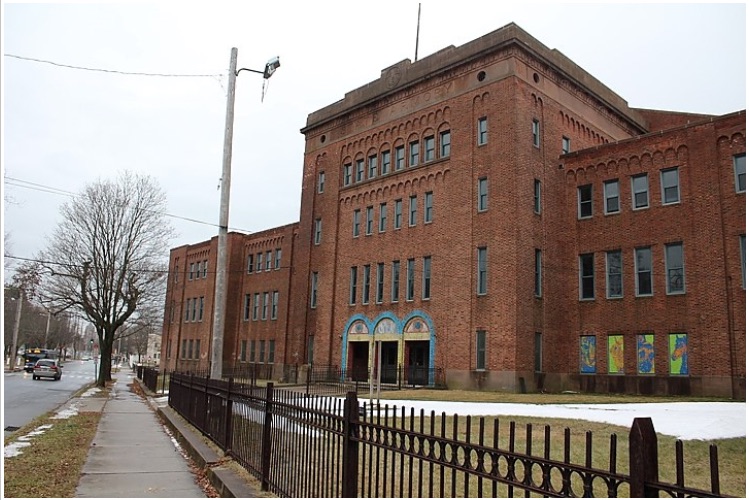
The Goffe Street Armory (pictured from Goffe) two winters ago. Paul Bass Photo for the New Haven Independent.
Rubin will present the project again this Wednesday, at a monthly Pecha Kucha at Lotta Studio. The event begins at 7 p.m.
“Excavating the Armory” began earlier this year as a commission for Artspace’s annual City-Wide Open Studios (CWOS). At that time, Rubin asked both high school and graduate students to reimagine the Goffe Street landmark, drawing on its history and similar precedents across the country (read about that here). Last month, they presented their findings in the Armory, taking new suggestions from WEB neighbors and CWOS attendees on a giant sheet of paper called a “Futures Canvas.”
Then the project outlived CWOS. Last month, Artspace director Helen Kauder asked community members for feedback at a management team meeting, doubling down on a new commitment to the neighborhood. Last week, Rubin arrived with a recap, fielding suggestions on where it may go next. He arrived with a series of large boards and posters summarizing the work he and his students have already completed, which includes a timeline and precedent study that is almost finished.
The biggest barrier is financial. While Rubin said he does not have a number in mind, comparable armory rehabs across the country have ranged from millions to hundreds of millions of dollars. In previous conversations about the building, city Economic Development Administrator Matthew Nemerson has estimated that a complete rehab of the building would cost tens of millions.
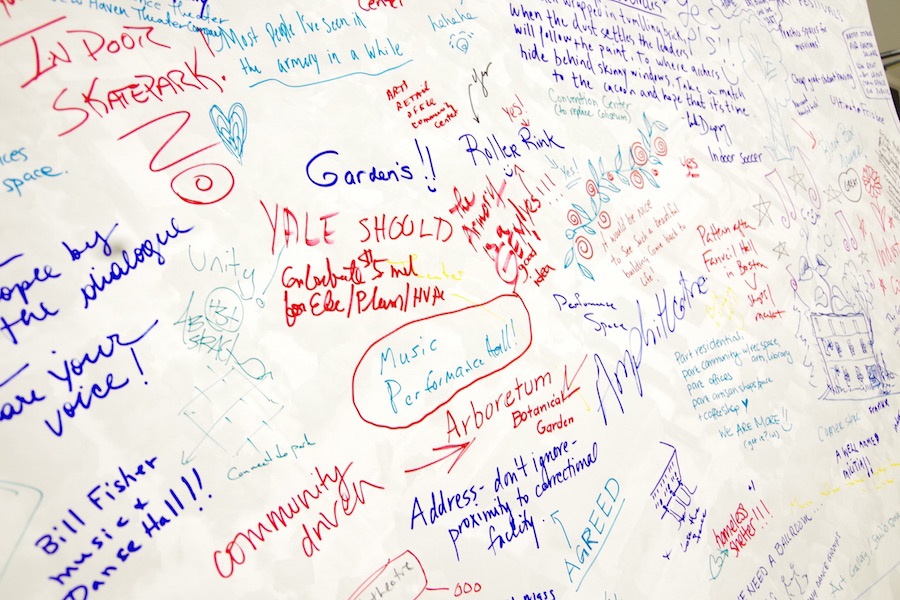
Just one segment of the "Futures Canvas." Lucy Gellman Photo.
Among other concerns, Nemerson listed the Armory’s lack of plumbing, need for new HVAC technology, leaky and structurally unsound roof, and lack of handicap access. City Engineer Giovanni Zinn has confirmed that city planners are currently doing a code analysis on the roof and plan to do repairs when it is finished. As of August, the city had $250,000 in bond funds for roof repairs.
Taking the stage at the substation, Rubin made his pitch on “how we save this Armory and make it useful to the people of New Haven.”
“What we found is that there are many people who care about the Armory,” he said. “It must be preserved. You could never build anything like this ever again.”
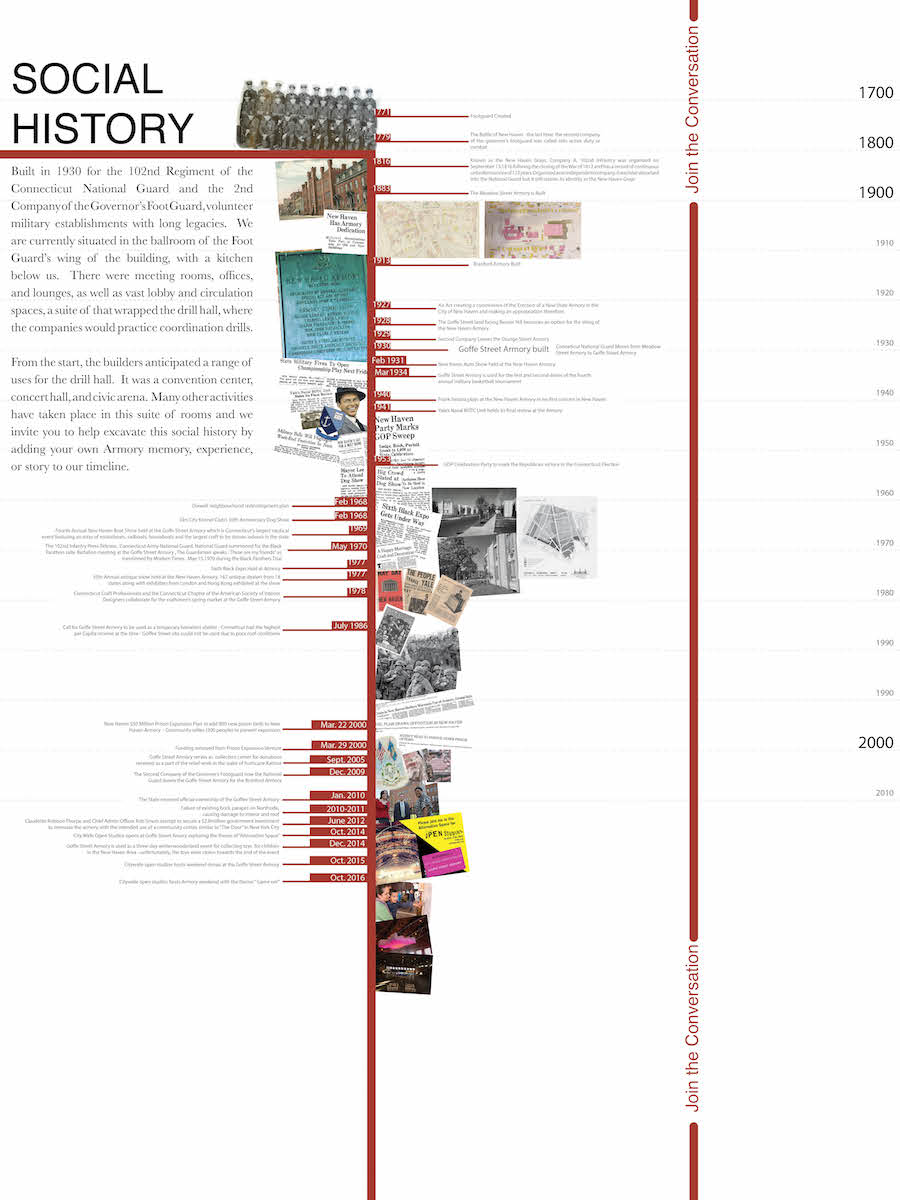
"Excavating The Armory" includes a partial social history that Rubin and his students have reconstructed. Image courtesy Elihu Rubin.
He is still figuring out the best way to do that, he told the group—but he’s discovered a rich social history of the building that’s made him a fierce advocate for saving it. Completed for the Connecticut Foot Guard in 1930, the Armory was home to dog, antique, and boat shows and one Black Expo through the 1960s and 1970s, and ground zero for the National Guard when it was summoned to New Haven during the 1970 Black Panthers trial.
In 2000 it was considered for a $50 million Prison Expansion Plan that never came through. It was handed over to the city after the Foot Guard left in 2009 for the Branford Armory, and has been empty since. Since that date there have been murmurs about the building’s rebirth, and the city’s Board of Alders has made at least one appeal for state funds.
“We’d like to think that there’s a chance for public, private and nonprofit partnerships.” Rubin said. He added that “we have to demand that the city stabilize this building immediately. That’s my personal opinion.”
A few attendees were interested in knowing more about possible sources of funding, on which Rubin said his students are still doing exploratory research. (He has not yet invited the city as a partner on the project, nor has he spoken to Nemerson about it). One, who asked not to be identified, said she is surprised that Yale University has not tried to claim the building.
Most, however, were quicker to add their own plans to the “Futures Canvas.” From one side of the room, skate enthusiast Patrick Escandon proposed an indoor skate park and recreation center in the building’s central drill hall, with rec rooms and studio space off to the side. He suggested gathering an informal group of roofers, plumbers, and carpenters to look at the building “if the city doesn’t want to do it,” a proposal that Rubin said would likely be untenable.
Alder Jill Marks said she envisions an after-school sports hub, with a tunnel reaching from the Armory’s second floor onto Goffe Street Park below. As a founding member of Friends of Goffe Street Park earlier this year, she said that she wants to be sure that the park and its frequent visitors play a role in whatever the building becomes.
“We need a place for our youth,” she said. She added that she would like to see a wintertime flea market in the space, a suggestion that had been floated around briefly earlier in the meeting.
WEB born and bred Stephani Johnson recalled attending a 1977 antique show with her grandmother at the Armory. “I hope something actually happens because it is a great space,” she said, adding that she’s in favor of several of the ideas on the futures canvas like a cat cafe, yoga studio and dance hall, but would love to see antique or bric-a-brac exhibitions come back there several times a year.
And WEB CMT Chair Nadine Horton, who attended as both a member of “Excavating The Armory” and a proud parent of a first-time exhibitor, echoed her previous statement that she’d like to see it become some sort of arts and community hub. “This is a treasure in our neighborhood, so we have to preserve it,” she added. She also said that she is moving towards forming an "Armory community advisory committee" that will be "looking to meet up in the next couple weeks."
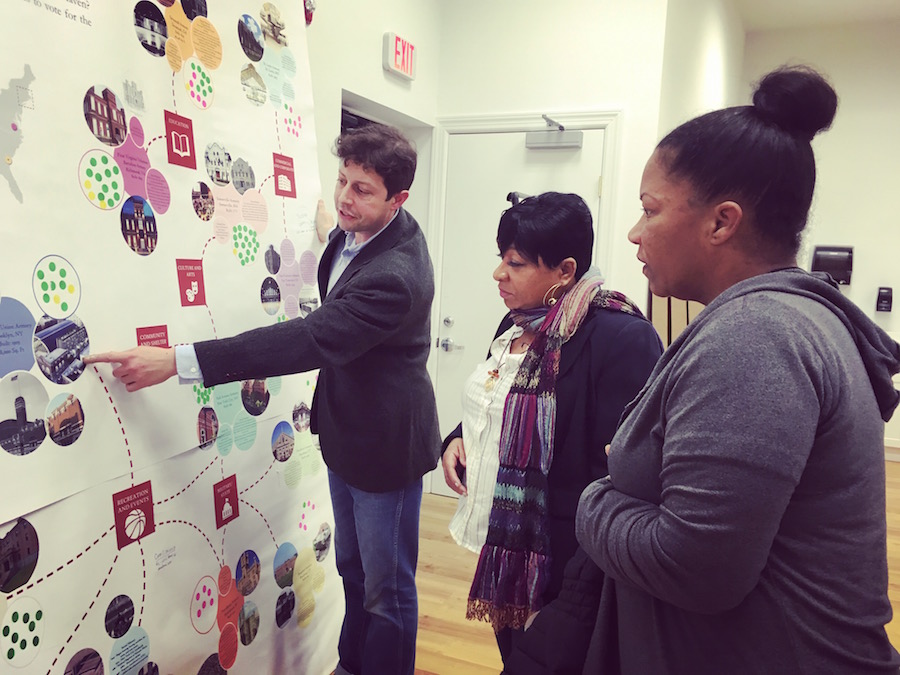
In the near future, Kauder, Rubin and Horton said there’s a more pressing need: ensuring there’s a CWOS weekend in the space next year. In the months before CWOS 2017, Artspace was almost denied permitting from the city, because of outstanding concerns that the building is no longer fit for public assembly. Reached by phone, Nemerson said that building officials and the fire marshall had given the organization and the city a six-month ultimatum to “make sure that we answer all the questions that the fire marshall and the building officials had for us.”
He also said that the notion that the city is not invested in the building is “silly and naive.”
“We are putting all sorts of effort to keep it going from year to year for Open Studios,” he said, noting the city’s prior discussions on moving offices, the Board of Education, or other departments there. “The issue with an armory in a city like New Haven is you have to identify a revenue stream for fixing it up.”
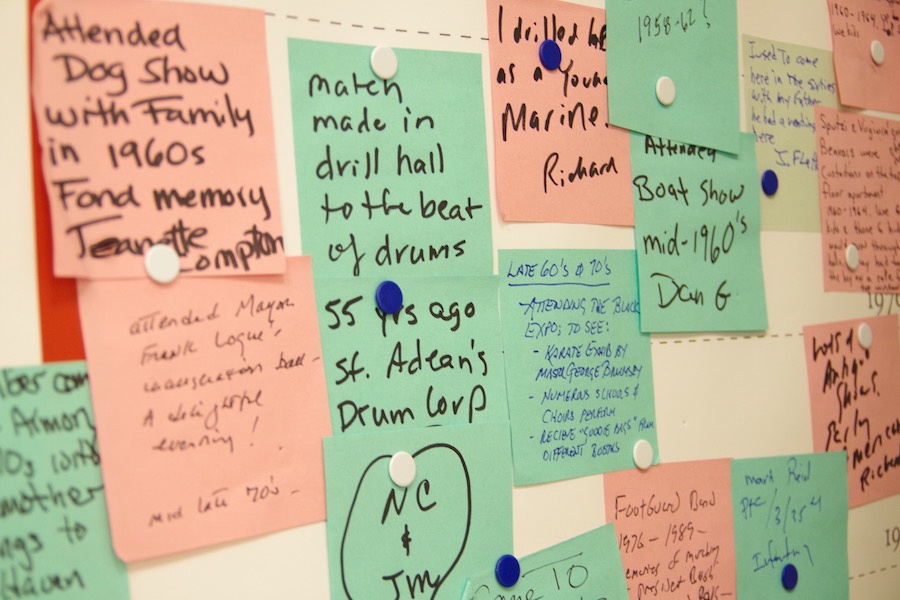
During CWOS, people wrote down their memories of the Armory. Rubin kept those post-its in one place. Lucy Gellman Photo.
That’s a revenue stream that’s increasingly harder to find as federal, state and local budgets tighten and reallocate resources, he added. He noted that a private developer or nonprofit stewardship model, whereby an organization like Artspace or The Arts Council of Greater New Haven would take it on as a fundraising cause, are both things that the city is thinking about at this time.
“We are reaching sort of a point of no return as far as the condition of the building,” he said. “There are all sorts of reasons why a spectacular, historic building like that wants to be saved, just as there are reasons that it’s hard to do.”
Back at the meeting, Rubin was chatting with WEB advocate Chris Peralta as attendees looked at the boards and milled around the room. “We’re going to keep talking and strategizing … We’ll keep pushing the city in different directions,” he told Peralta.
Of next steps, he added that he wasn’t sure what was best. “Is it a letter on Toni Harp’s desk?”